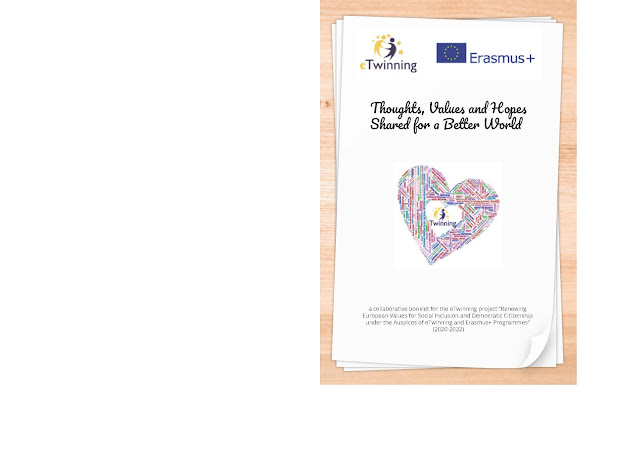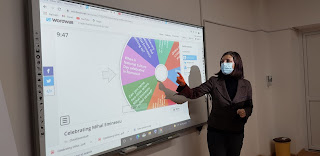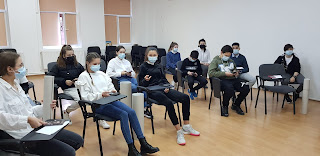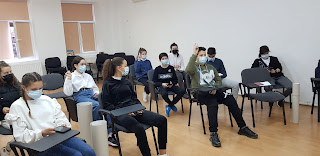Monday 31 January 2022
Friday 28 January 2022
Bibliography List of Sources Used for Teaching English (2021-2022)
1. Evans, Virginia 2002, Successful Writing, Express Publishing;
2. Harmer, Jeremy 2001, The Practice of English Language Teaching, Pearson Education Limited;
3. Scrivener, Jim 2008, Learning Teaching, Macmillan;
4. Swan, Michael 1996, Practical English Usage, Oxford University Press;
5. Vince, Michael 2007, English Grammar in Context Intermediate with Key, Macmillan;
6. Vince, Michael, Advanced Language Practice, Third Edition, Macmillan;
7. Vizental, Adriana, 2014, Metodica Predării Limbii Engleze, Ed. Polirom;
8. Common European Framework of Reference for Languages: Learning, Teaching, Assessment (CEFR) /Cadrul European Comun de Referință pentru Limbi/ https://www.coe.int/en/web/common-european-framework-reference-languages .
Wednesday 26 January 2022
The Collaborative Bulb Planting Activity for the eTwinning Project "Today's Seeds, Tomorrow's Trees"
January 2022 brought about the first collaborative activity of the eTwinning project "Today's Seeds, Tomorrow's Trees".
The students of Liceul Teoretic "Radu Vladescu", Pătârlagele, together with four of their teachers, joyfully accepted the invitation made by the project founder, Mrs. Maria Pană, from Liceul Teoretic "Nicolae Iorga, Nehoiu, and started preparations for the bulb planting activity.
We decided to plant three different types/species of bulbs in flower pots - paperwhite narcissus (narcise albe), tulips (lalele) and hyacinths (zambile) - before transplanting them into the school garden.
We prepared the soil, determined the planting depth (in our case it was two to three times as deep as the bulb was tall), then we planted and watered the bulbs and placed the pots in a classroom with controlled conditions of light, temperature and humidity.
Hopefully, this spring will bring new beauty and more joy into our lives!
Monday 24 January 2022
Preparations for the Planting of Spring Flower Bulbs - Together for a Season of Hope and Solidarity (one of the activities of the eTwinning project "Today's Seeds, Tomorrow's Trees")
In January 2022, the initiator and coordinator of the international eTwinning project "Today's Seeds, Tomorrow's Trees", Mrs. Maria Pană, a teacher of English at Liceul Teoretic "Nicolae Iorga", Nehoiu, invited all the partner schools to plant perennial bulbs of plants with spring flowers such as tulips (lalele), hyacinths (zambile) or daffodils (narcise galbene) etc.
With the help of wikipedia, the free enciclopedia, we learned the following information about the spring flowers we had decided to enrich our school garden with:
Narcissus papyraceus (from papyrus and aceus; meaning paper-like, one of a few species known as paperwhite, is a perennial bulbous plant native to the Mediterranean region, from Greece to Portugal plus Morocco and Algeria. The species is considered naturalized in the Azores, Corsica, Texas, California and Louisiana. The white flowers are borne in bunches and are strongly fragrant. It is frequently grown as a house plant, often forced to flower at Christmas.
The narcissus appears in two Graeco-Roman myths, that of the youth Narcissus who was turned into the flower of that name, and of the Goddess Persephone snatched into the Underworld by the god Hades while picking the flowers. The narcissus is considered sacred to both Hades and Persephone,and to grow along the banks of the river Styx in the underworld.
The Greek poet Stasinos mentioned them in the Cypria amongst the flowers of Cyprus. The legend of Persephone comes to us mainly in the seventh century BC Homeric Hymn To Demeter, where the author describes the narcissus, and its role as a lure to trap the young Persephone. The flower, she recounts to her mother was the last flower she reached for before being seized.
Other Greek authors making reference to the narcissus include Sophocles and Plutarch. Sophocles, in Oedipus at Colonus utilises narcissus in a symbolic manner, implying fertility, allying it with the cults of Demeter and her daughter Kore (Persephone), and by extension, a symbol of death. Jebb comments that it is the flower of imminent death with its fragrance being narcotic, emphasised by its pale white colour. Just as Persephone reaching for the flower heralded her doom, the youth Narcissus gazing at his own reflection portended his own death.Plutarch refers to this in his Symposiacs as numbing the nerves causing a heaviness in the limbs. He refers to Sophocles' "crown of the great Goddesses", which is the source of the English phrase "Chaplet of the infernal Gods" incorrectly attributed to Socrates.
A passage by Moschus, describes fragrant narcissi.Homer in his Odyssey described the underworld as having Elysian meadows carpeted with flowers, thought to be narcissus, as described by Theophrastus. A similar account is provided by Lucian describing the flowers in the underworld.The myth of the youth Narcissus is also taken up by Pausanias. He believed that the myth of Persephone long antedated that of Narcissus, and hence discounts the idea the flower was named after the youth.
Paperwhites are part of the genus Narcissus which includes plants known as daffodils. The Romantic poet William Wordsworth celebrated the beauty of daffodils in the poem "I Wandered Lonely as a Cloud":
I wandered lonely as a cloud
That floats on high o'er vales and hills,
When all at once I saw a crowd,
A host, of golden daffodils;
Beside the lake, beneath the trees,
Fluttering and dancing in the breeze.
Continuous as the stars that shine
And twinkle on the milky way,
They stretched in never-ending line
Along the margin of a bay:
Ten thousand saw I at a glance,
Tossing their heads in sprightly dance.
The waves beside them danced; but they
Out-did the sparkling waves in glee:
A poet could not but be gay,
In such a jocund company:
I gazed—and gazed—but little thought
What wealth the show to me had brought:
For oft, when on my couch I lie
In vacant or in pensive mood,
They flash upon that inward eye
Which is the bliss of solitude;
And then my heart with pleasure fills,
And dances with the daffodils.
Tulips (Tulipa) are a genus of spring-blooming perennial herbaceous bulbiferous geophytes (having bulbs as storage organs) whose flowers are usually large, showy and brightly colored, generally red, pink, yellow, or white (usually in warm colours). The tulip is a member of the lily family, Liliaceae, along with 14 other genera, where it is most closely related to Amana, Erythronium and Gagea in the tribe Lilieae. There are about 75 species, and these are divided among four subgenera. The name "tulip" is thought to be derived from a Persian word for turban, which it may have been thought to resemble by those who discovered it. Tulips originally were found in a band stretching from Southern Europe to Central Asia, but since the seventeenth century have become widely naturalised and cultivated. In their natural state they are adapted to steppes and mountainous areas with temperate climates. Flowering in the spring, they become dormant in the summer once the flowers and leaves die back, emerging above ground as a shoot from the underground bulb in early spring.
Growing wild over much of the Near East and Central Asia, tulips were cultivated in Constantinople as early as 1055. By the 15th century, tulips were among the most prized flowers; becoming the symbol of the Ottomans.While tulips had probably been cultivated in Persia from the tenth century, they did not come to the attention of the West until the sixteenth century, when Western diplomats to the Ottoman court observed and reported on them. They were rapidly introduced into Europe and became a frenzied commodity during Tulip mania. Tulips were frequently depicted in Dutch Golden Age paintings, and have become associated with the Netherlands, the major producer for world markets, ever since. In the seventeenth century Netherlands, during the time of the Tulip mania, an infection of tulip bulbs by the tulip breaking virus created variegated patterns in the tulip flowers that were much admired and valued. While truly broken tulips do not exist anymore, the closest available specimens today are part of the group known as the Rembrandts – so named because Rembrandt painted some of the most admired breaks of his time.
Here is a short poem, "Love In A Tulip", written by Belinda Hicks:
Roses are beautiful for a show
Daises are nicer for their peaceful nature
But if it’s true love you want to show
A red tulip is the way to go
The red tulip has always been
The real declaration of true love
It’s black center showing
The hearts burning with passion
Roses are nothing but a mere decoration
As for daises its serenity and peace
If love is what your going for
Then give her a tulip and she will know
The love you have for her
Hyacinthus is a small genus of bulbous, spring-blooming perennials. They are fragrant flowering plants in the family Asparagaceae, subfamily Scilloideae and are commonly called hyacinths /ˈhaɪəsɪnθs/. The genus is native to the area of the eastern Mediterranean from the north of Bulgaria through to the northern part of the region of Palestine.Hyacinths are often associated with spring and rebirth.
The hyacinth flower is used in the Haft-Seen table setting for the Persian New Year celebration, Nowruz, held at the Spring Equinox. The Persian word for hyacinth is سنبل (sonbol).The name ὑάκινθος (hyakinthos) was used in Ancient Greece for at least two distinct plants, which have variously been identified as Scilla bifolia or Orchis quadripunctata and Consolida ajacis (larkspur).Plants known by this name were sacred to Aphrodite.According to Greek mythology, the flower was created by the god Apollo in commemoration of his lover Hyacinthus, whom he had accidentally killed, and who was worshipped as a hero at Amyclae, southwest of Sparta.[citation needed]
The hyacinth appears in the first section of T.S. Eliot's "The Waste Land" during a conversation between the narrator and the "hyacinth girl" that takes place in the spring.
"You gave me hyacinths first a year ago;
“They called me the hyacinth girl.”
—Yet when we came back, late, from the Hyacinth garden,
Your arms full, and your hair wet, I could not
Speak, and my eyes failed, I was neither
Living nor dead, and I knew nothing,
Looking into the heart of light, the silence."
Thoughts, Values and Hopes Shared for a Better World, a collaborative brochure created by two classes of Romanian sophomores for the eTwinning project “Renewing European Values for Social Inclusion and Democratic Citizenship under the Auspices of eTwinning and Erasmus+ Programmes” (2020-2022)
Follow the link below to visit the original booklet created with Book Creator, a collaborative online tool:
Thoughts, Values and Hopes Shared for a Better World
Thursday 20 January 2022
Celebrating Mihai Eminescu, a transdisciplinary lesson for the eTwinning project "Împreună pentru profilul absolventului/Together for the Graduate Profile"
On January 19, 2022, the students enrolled in class 8B at Liceul Teoretic "Radu Vlădescu" Pătârlagele, coordinated by their teacher of Romanian, Mrs. Adelaida Iorga, and their teacher of English, Mrs. Emilia Frînculeasă, participated in a transdisciplinary lesson dedicated to the celebration of Mihai Eminescu, Romania's National Poet, and meant to integrate a variety of learning activities and experiences, promote interaction, collaboration, teamwork, creativity and innovation and ultimately provide opportunities for the future graduates to develop their key competences and 21st century skills.
The English component of the lesson included the following activities:

































































